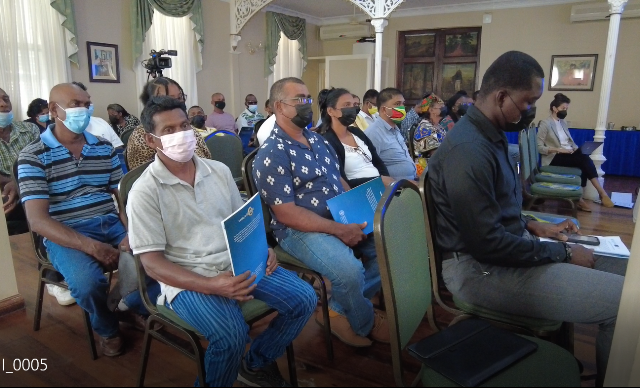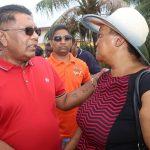Guyana, the largest producer of Atlantic seabob, is one of two Caribbean countries and one of 12 countries in the Africa, Caribbean and Pacific (ACP) selected for the ‘FISH4ACP’ programme.
The initiative seeks to enhance the productivity and competitiveness of the Atlantic seabob fishery in Guyana, where it is expected that the emerging oil and gas sector will increase demand.
Local stakeholders including from the Ministry of Agriculture’s Fisheries department, the Guyana Fisherfolk Organisation, and the Corentyne Fishermen’s Co-op society, on Wednesday, signed what is called the “Declaration of Georgetown” which signals the implementation of the seabob shrimp value chain upgrading strategy in Guyana.
Speaking to the gathering of stakeholders, Permanent Secretary of the Ministry of Agriculture Delma Nedd, noted the importance of the fisheries sector in the area of food security, as fish is the main source of animal protein in Guyana.
“Therefore, the main objective of this project, which is to contribute to poverty reduction, job creation, food and nutrition security, directly aligns with the vision of the fisheries sector in Guyana,” Nedd said.
She noted that the local sector employs approximately 12,000 people in harvesting, 5,000 in processing and marketing, amounting to 15, 000 jobs directly depending on fishing, with more benefitting indirectly.
She noted that there has been much improvement in the sustainable development of the industry in recent years, such as acquiring the requisite standards for fish export to the EU market, and has commenced exporting to the EU and the US markets.
“The seabob shrimp industry has attained marine stewardship certification, which allows access to premium process for sustainable harvested seabob shrimp,” Nedd noted.
She said Guyana has been investing a lot to fully realise the potential of the aquaculture industry, despite being at a very early stage.
“Having recognised high production costs, the government has pledged its commitment, by allocating a 65 percent increase in our 2022 budget, that is $430 million.
“As we progressively develop the industry, the government will further promote the use of a wider range of farm species, more emphasis will be placed on value chain analysis, and development to promote marketing of farm products, and the establishment of aquaculture zones or hubs for potential investors.”
She noted the benefits that will be derived from the project for Guyana including a strengthened position as a leading exporter of seabob shrimp globally, increasing the sustainability of Guyana’s marine seabob shrimp, improving social development particularly in the fishing community and greater access to regional and international trade markets.
“FISH4ACP will work to increase the production of small-scale fishers in the sector, and strengthen the role of women and youth…while seeking to improve safety and workers’ rights. At the same time, it will support efforts to reduce bycatch in particular of endangered species,” Nedd said.
Today’s launch was a culmination of a series of workshops and meetings held between various stakeholders and international partners regarding the programme.
It is an initiative of the Organisation of African, Caribbean and Pacific States (OACPS)and financed by the European Union (EU) and the German Federal Ministry for Economic Cooperation and Development (BMZ) and implemented by the FAO.
Guyana harvests 20,000 tonnes of seabob annually at an estimated value of US $50 million.








